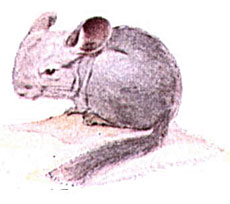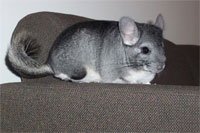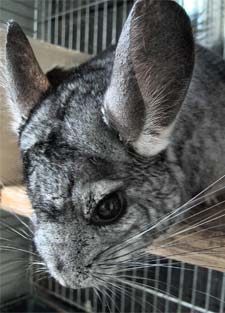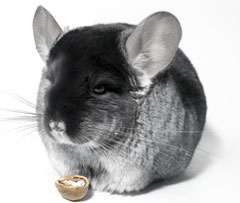|

 Fur: the love of softness... Chinchilla fur is considered the softest in the world and is thirty times softer than human hair. Chinchillas must regularly bathe in dust or volcanic ash to remove oil and moisture that gathers in their thick fur. Fur: the love of softness... Chinchilla fur is considered the softest in the world and is thirty times softer than human hair. Chinchillas must regularly bathe in dust or volcanic ash to remove oil and moisture that gathers in their thick fur.
In fact, they have the highest fur density of any land animal with more than 20,000 hairs per square cm. Their fur is so dense that skin parasites (such as fleas) cannot live on one lest they suffocate. Where humans grow one hair from each follicle, a chinchilla has more than fifty hairs from a single follicle.
Shades of Gray: In nature, chinchillas are gray, while other colors have been developed in captivity. For example white, mosaic (white with gray or black patches), beige (very light gray), violet, black velvet, brown velvet and Panda colors have been seen. The gene for white is dominant, but lethal in the absence of a recessive gene of another color. Some mixture of genes that generate some colors, such as sapphire, are more likely to cause disease or deformity in offspring. Red eyes are not only a sign of albinism but associated with beige colored-chinchillas.

Birds and Bees: In nature, chinchillas live in colonies. Chinchilla females are significantly bigger than males. Chinchillas can breed any time of the year. They have a very long gestation period for a rodent of 111 days. Due to this long pregnancy, chinchillas are born fully furred and open their eyes soon after birth. Litters range from one to seven babies, although the average litter size is two. In the case of a miscarriage, the fetus is frequently absorbed into the body of the mother, resulting in further sterility.
 Chirping Rodents: Prone to excited sounds, chinchillas will also emit chirps and calls according to their mood. Over time an owner will hear a multitude of these orations, all indicating the animal's personal state. A soft cooing might indicate playfulness and comfort. Chirping Rodents: Prone to excited sounds, chinchillas will also emit chirps and calls according to their mood. Over time an owner will hear a multitude of these orations, all indicating the animal's personal state. A soft cooing might indicate playfulness and comfort.
A very quiet chirping can be heard while the chinchilla is exploring a new place. Some sounds will originate from the grinding of teeth, which they will sometimes do after eating. They do sneeze audibly, sometimes from the fine dust in their bath.
Warning Sounds: If a chinchilla feels threatened, a high and loud bark will be heard, much like a squirrel can bark. A last resort will involve the chinchilla standing on hind legs and emitting both a bark and a stream of urine. Sometimes, chinchillas will emit a series of loud, hoarse barks that serve to warn other chinchillas of potential danger. They nearly always use this vocalization if they feel nervous, rather than in response to a specific threat. Many will make this noise in response to bad dreams or even loneliness.

In the Wild: In their native habitat, chinchillas live in burrows or crevices in rocks. They are agile jumpers and can jump up to five feet above their head. Predators in the wild include hawks, skunks, felines, and canines. Their diet consists of plants, fruits, seeds, and small insects.
Chinchilla Trade: The international trade in chinchilla fur goes back to the 1500s and the animal (whose name literally means "Little Chincha") is named after the Chincha people of the Andes, who wore its soft and dense fur. By the end of the 19th century, chinchillas had become quite rare.
In 1923, Mathias F. Chapman brought the eleven wild chinchillas he had captured to the U.S. for breeding. Only three of these were female. Since the mid-1960s, chinchillas have become increasingly popular as house pets. This peculiar rodent is also studied by linguists due to its aural range of perception. It is considered the closest to that of a human.
--------------------------------------------------------------------------------------------------------------------------
 Chinchillas as Pets: Chinchillas make charming pets, but they are naturally skittish and are not considered to be good pets for small children as they have delicate bones and generally do not like to be held. Chinchillas as Pets: Chinchillas make charming pets, but they are naturally skittish and are not considered to be good pets for small children as they have delicate bones and generally do not like to be held.
However, some enjoy snoozing in laps and posing for pictures as well as being held, petted and gently scratched.
As with most creatures, temperament depends largely on upbringing and to a degree genes.
Furry Personalities: Intelligent creatures, chinchillas may be taught tricks (rolling over, sitting up, etc.) with enough patience, using clearly spoken verbal cues over time in a quiet room. Each chinchilla has a distinctive personality, even from birth. Some like being held more than others, some prefer certain types of food, and some are more sleepy and lazy than others. While females can sometimes be more territorial than males, gender mostly does not affect temperment in chinchillas.
Long Live the Chinchilla: In captivity, chinchillas can live past twenty years, and grow to about one foot in length, but they usually do not live for more than ten years in countries with a climate to which they are not adapted. Chinchillas that are kept as pets with proper care can live longer than chinchillas in large ranches, where chinchillas often are kept only in the most economical housing with little space. Differences in diet, environment, and housing may contribute.
 A Room of One's Own: Chinchillas should be kept in a large cage, the bigger the better, at least 80 cm × 50 cm × 80 cm per animal. If there is any possibility of a pregnancy, cage bar spacing should not exceed (1/2" × 1"), as small chinchillas are good climbers and can easily squeeze through small holes (their fur makes them look larger than they are). A Room of One's Own: Chinchillas should be kept in a large cage, the bigger the better, at least 80 cm × 50 cm × 80 cm per animal. If there is any possibility of a pregnancy, cage bar spacing should not exceed (1/2" × 1"), as small chinchillas are good climbers and can easily squeeze through small holes (their fur makes them look larger than they are).
Cages should also avoid walking surfaces made of metal fencing as chinchillas can catch a limb under the metal and suffer serious injury.
Exercise Wheels, Ledges, and Boxes: Chinchillas enjoy ledges, boxes, sticks, and other perches, as well as exercise wheels, which must be chosen with safety in mind.
In particular, exercise wheels should be at least 15 inches in diameter (anything smaller can hurt chinchillas' backs), and if mesh is used, the mesh must be sufficiently fine to prevent limbs or digits from being caught. It is much better to have a solid running surface, as they cannot get their toes or legs stuck. Chinchillas should not have wheels that have support bars (bars going from top to bottom on the wheel), as these can amputate chinchilla fingers and toes and break chinchilla's necks if they hop out of the wheel while it is still rolling.
No Sweat: Chinchillas cannot sweat, and therefore are prone to overheating, sometimes fatally. An overly warm chinchilla is characterized by veins prominently visible in the ears, warm feet, and lethargy. Heat stroke can lead to death. Thin cuts of granite are very useful for helping a chinchilla stay cool. The climate in which your chinchilla lives should never exceed temperatures of 25 °C (75 °F), and should always have ample air circulation.

Peace in the Home: Animals of the same sex live peacefully together in a single cage with sufficient space, and a male can usually be kept with one or more females.
Male chinchillas will fight each other for a mate and therefore no more than one male should be kept with a female but two females must have extra precaution because they may fight also.
If living space is too small, chinchillas will become extremely territorial. However, chinchillas will mate with members of their own family, so male babies cannot be left for too long in the same cage as their mother.
Best Bedding: Red cedar bedding is toxic to chinchillas because it contains large amounts of chemical substances called phenols and should not be used. Pine shavings are acceptable, but if they are too fine they can cause eye infections or irritate the animal's airways. Pine shavings must be kiln-dried though, because the kiln drying process evaporates phenols away from the wood. Aspen is the preferred bedding used by most pet breeders and conscientious owners. It emits no phenols and is appealing for some chinchillas to chew. The bedding should be changed at least once a week, and the food, water and hay changed and refilled daily.
To Keep Your Chinchilla Clean: Chinchillas clean their fur by rolling in a dust bath. Fine dust cleans most effectively, but specially processed sand made from pumice avoids the problems of fine dust. Fine pumice dust, albeit messy, is better for the fur quality of the chinchilla because, unlike sand, the dust can fully penetrate the dense fur. The fur of a chinchilla should never be allowed to get wet. Chinchillas have no guard hairs, so the underfur can retain water, creating a warm moist environment for growth of the fungus ringworm, also (known as athlete's foot).
Dust Bath:Some owners have found success in adding powered Tinactin to the dust bath in order to treat ringworm but some chinchillas will decline to bathe in the dust once it has been medicated. Application of cream Tinanctin with a Q-tip to the effected area proves effective. Other anti-fungals generally available are not as effective because they have a different active ingredient. Some owners also give de-wormer and anti-parasite orally every month but this can be discussed with your vet.
A wet chinchilla should be dried with a towel and a hair blow dryer with no heat added. If the chinchilla is very cold or shivering it is possible to dry them with a hair dryer using very low heat and with the dryer held about 2 feet away.
Playtime: Many chinchilla owners prefer to provide playtime out of the cage, although this is not essential to the animal's health. An exercise time in a special "chinchilla-proofed" room is optimal, as a wheel or similar exercise device in the cage is not enough. They enjoy leaping from furniture and running around.
 They must be watched at all times, as they can escape from even a well-prepared room. If provided with nothing else, they will chew on wood, wire (electrical or otherwise), and anything else they can find. They must be watched at all times, as they can escape from even a well-prepared room. If provided with nothing else, they will chew on wood, wire (electrical or otherwise), and anything else they can find.
To prevent this, items such as paper towel tubes or wooden chew toys should be provided both during the exercise time and in the cage.
A Scratched Nose: Some chinchillas are prone to cuts and scratches, especially on the nose. It is important that this be dealt with quickly to avoid infection. A first-aid topical antibiotic ointment is generally the best option, though if the problem area is on the nose it is crucial that it does not block the nostrils. Most vets do not take chinchillas, so owners will need to find a special exotics vet that is experienced in chinchillas.
Feed the Furry: Chinchillas have quite delicate digestive systems and so have special dietary requirements. It is usually easiest to feed them specially formulated chinchilla food. Rabbit food and hamster food does not meet the nutritional needs of chinchillas and frequently makes them fat, as does too much rusk or raisin. Chinchillas are very sensitive to sugars and can develop diabetes from obesity so no more than 1/2 of a raisin a day is recommended. Hay is an essential part of their diet, and should be fed at all times.
Hay, Hay, Hay: If their diet consists of an alfalfa based pellet, then they need timothy hay, and a timothy based pellet needs alfalfa hay. Perhaps as a treat they may have dandelion leaves if they are washed clean, a sugar-free cheerio, or a rose hip. Treats should be fed at the very most once a day, and it is better if they are fed less than even that. Chinchillas need to have a water bottle, as water in a dish or bowl will be quickly soiled and develop algae, which can be very bad for chinchillas. A bowl also poses the threat of water getting on the fur.
As with many rodents, Chinchillas emit a constant series of small droppings, particularly when they're excited or after they've eaten. This includes when they're out of their cage playing; however, most chinchillas will only urinate in their cages unless they feel threatened.

All text is available under the terms
of the GNU Free Documentation License
|